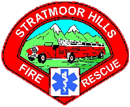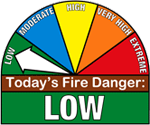Fire Prevention
Did You Know?!?
Residential fires claim the lives of 3,600 people each year and injure 18,500 more. Children younger than 5 are at greatest risk.
Would you know what to do if a fire started in your home? Would your child?
Fire Safety
- Are your electrical appliances in good condition, without loose or frayed cords or plugs?
- Are your outlets overloaded with plugs from the TV, computer, printer, video game system, and stereo?
- Are you overusing an extension cord?
- Do the light fixtures in your home contain bulbs that are the correct wattage?
- Does your home contain GFCIs (ground-fault circuit interrupters) and/or AFCIs (arc-fault circuit interrupters), which prevent electrical shock and fire by shutting off faulty circuits?
- Don’t run electrical wires under rugs.
- Make sure lamps and night-lights are not touching bedspreads, drapes, or other fabrics.
- Cover any outlets that are not in use with plastic safety covers if you have toddlers or young children in your home.
- Be especially vigilant about portable heaters
- Be careful in the kitchen
- Check out the fireplace
- Use candles safely
- Be aware of holiday dangers – Indoor & Outdoor lights
Household Tips
- Make sure all smoke alarms are in working order
- Keep fire extinguishers handy
- Plan escape routes
- Teach children the facts about fire
- Stop, Drop, and Roll to extinguish flames if an article of clothing catches on fire
- Crawl under the smoke to safety, staying as low to the ground as possible (smoke always rises)
- Practice fire drills at home
Prevent Carbon Monoxide Poisoning
The Stratmoor Hills Fire Department wants you to be aware of the dangers of carbon monoxide poisoning. Often called the invisible killer, carbon monoxide is an odorless, colorless gas created when fuels (such as gasoline, wood, coal, natural gas, propane, oil, and methane) burn incompletely. In the home, heating and cooking equipment that burn fuel are potential sources of carbon monoxide. Vehicles or generators running in an attached garage can also produce dangerous levels of carbon monoxide.
The dangers of CO exposure depend on a number of variables, including the victim’s health and activity level. Infants, pregnant women, and people with physical conditions that limit their body’s ability to use oxygen (i.e. emphysema, asthma, heart disease) can be more severely affected by lower concentrations of CO than healthy adults would be.
A person can be poisoned by a small amount of CO over a longer period of time or by a large amount of CO over a shorter amount of time. CO enters the body through breathing. CO poisoning can be confused with flu symptoms, food poisoning and other illnesses. Some symptoms include shortness of breath, nausea, dizziness, light-headedness or headaches. High levels of CO can be fatal, causing death within minutes.
Action Steps You Can Take:
SAFETY CHECKLIST
1. Follow the manufacturer’s instructions for placement and mounting height.
2. Choose a CO alarm that has the label of a recognized testing laboratory.
3. Test CO alarms at least once a month; replace them according to the manufacturer’s instructions.
1. If the audible trouble signal sounds, check for low batteries. If the battery is low, replace it. If it still sounds, call 9-1-1.
2. If the CO alarm sounds, immediately move to a fresh air location outdoors or by an open window or door.
3. Gas or charcoal grills can produce CO — only use outside.
4. If you need to warm a vehicle, remove it from the garage immediately after starting it.
5. Do not run a vehicle or other fueled engine or motor indoors, even if garage doors are open.
6. Make sure the exhaust pipe of a running vehicle is not covered with snow.
7. During and after a snowstorm, make sure vents for the dryer, furnace, stove, and fireplace are clear of snow build-up.
8. A generator should be used in a well-ventilated location outdoors away from windows, doors and vent openings.
*Source: National Fire Protection Association



